Wearever Pacemaker 1955-1959
by Jim Mamoulides, November 1, 2024
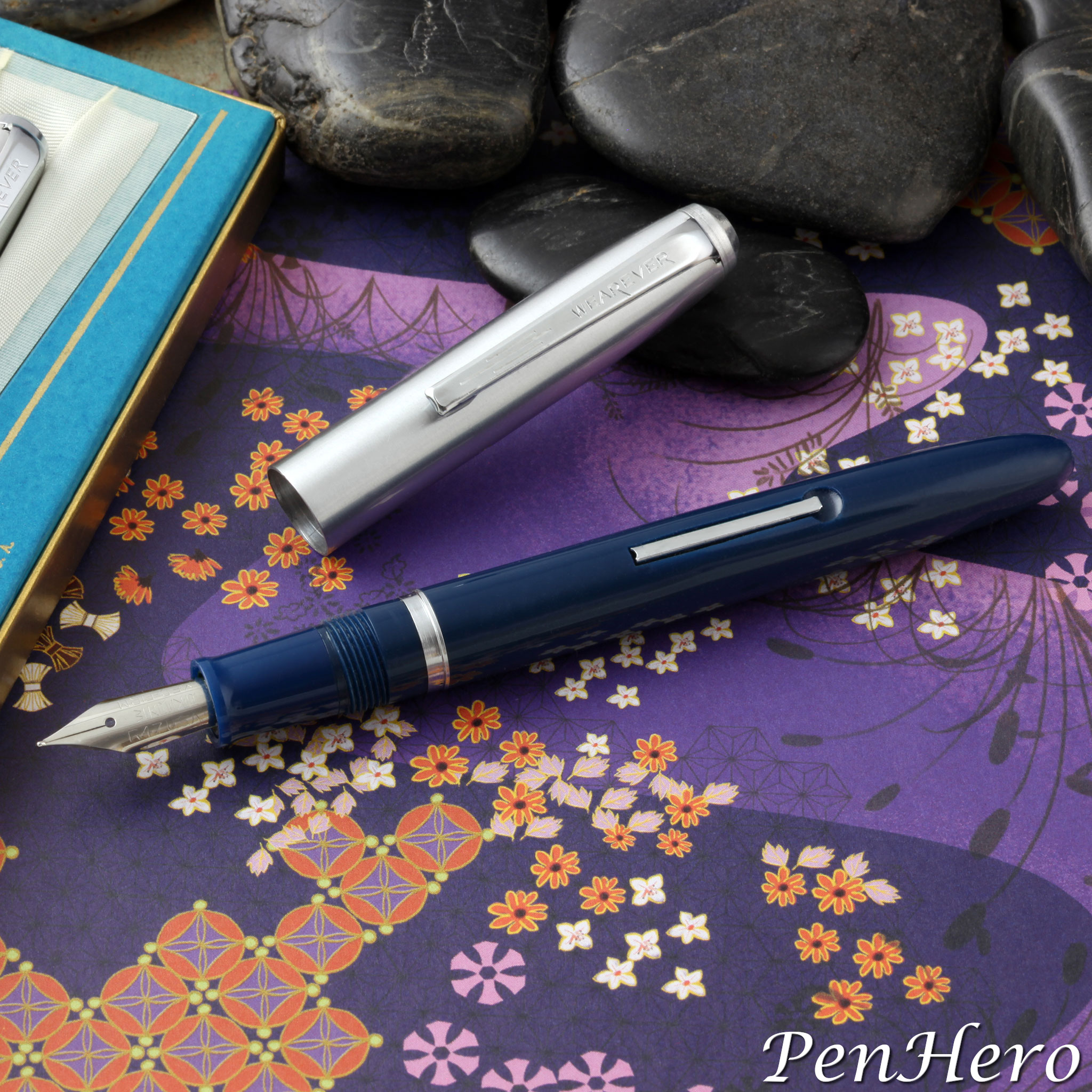 Wearever Pacemaker Blue 1955-1959
Wearever Pacemaker Blue 1955-1959
Wearever Sets the Pace!
Does it sound strange to say this is my favorite Wearever Pacemaker? Wait, there is more than one Wearever Pacemaker? We’ll get to that in a minute. Is it strange to even have a favorite Wearever pen? Anyone who has foraged for pens in the wild will wind up with a few Wearevers. It can’t be helped. David Kahn, Inc., established in 1896, and at this time located in North Bergen, New Jersey, was the company behind the Wearever brand. By the 1940s the company was calling itself “America’s Largest Fountain Pen Manufacturer,” probably meaning by volume. There are a lot of Wearever pens out there. A LOT.
I first noticed this type of Wearever Pacemaker when I was writing an article on the 1950s Wearever Pennant. Online searches would often turn up metal cap and plastic barrel Wearevers that were mislabeled Pennants or called simply “Wearevers.” Unless there is a price sticker on the cap or the barrel imprint is readable, it's understandable because this is a less common model. It's a better made than the Pennant, and as I found out, almost double the price.
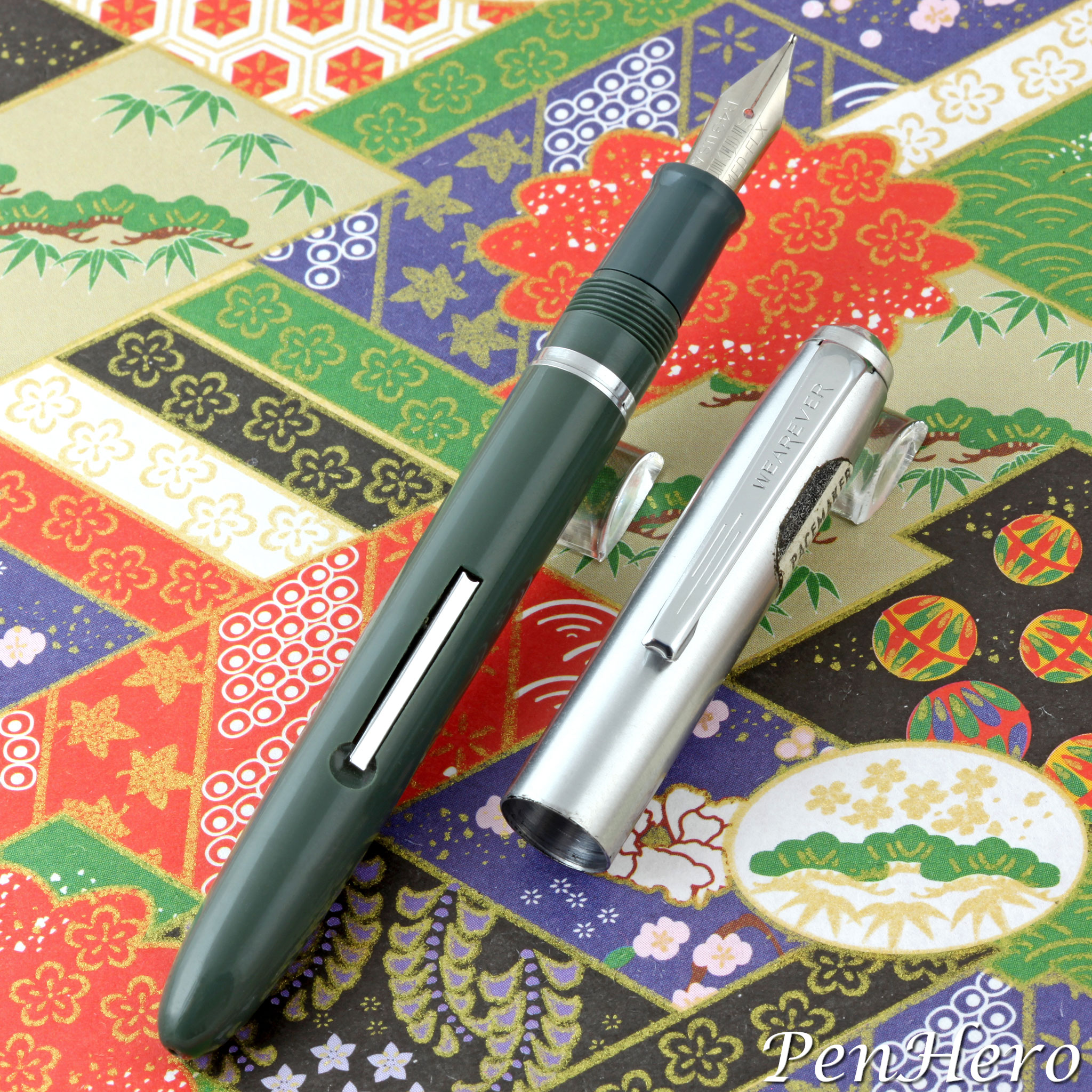 Wearever Pacemaker Grey 1955-1959
Wearever Pacemaker Grey 1955-1959
This is the third pen to be named Wearever Pacemaker, and each successive version is quite different than the previous. The first Pacemaker, made from 1944 to 1947, is a striped celluloid button-filling pen with a 14 karat gold nib. An obvious knock off of the 1940s striped Parker Duofold. David Kahn, Inc. received United States Trademark number 413,562, registered May 1, 1945, for the Pacemaker logo used with that pen, claiming it was in use since September 26, 1944. It was not used for either of the next two Pacemakers.
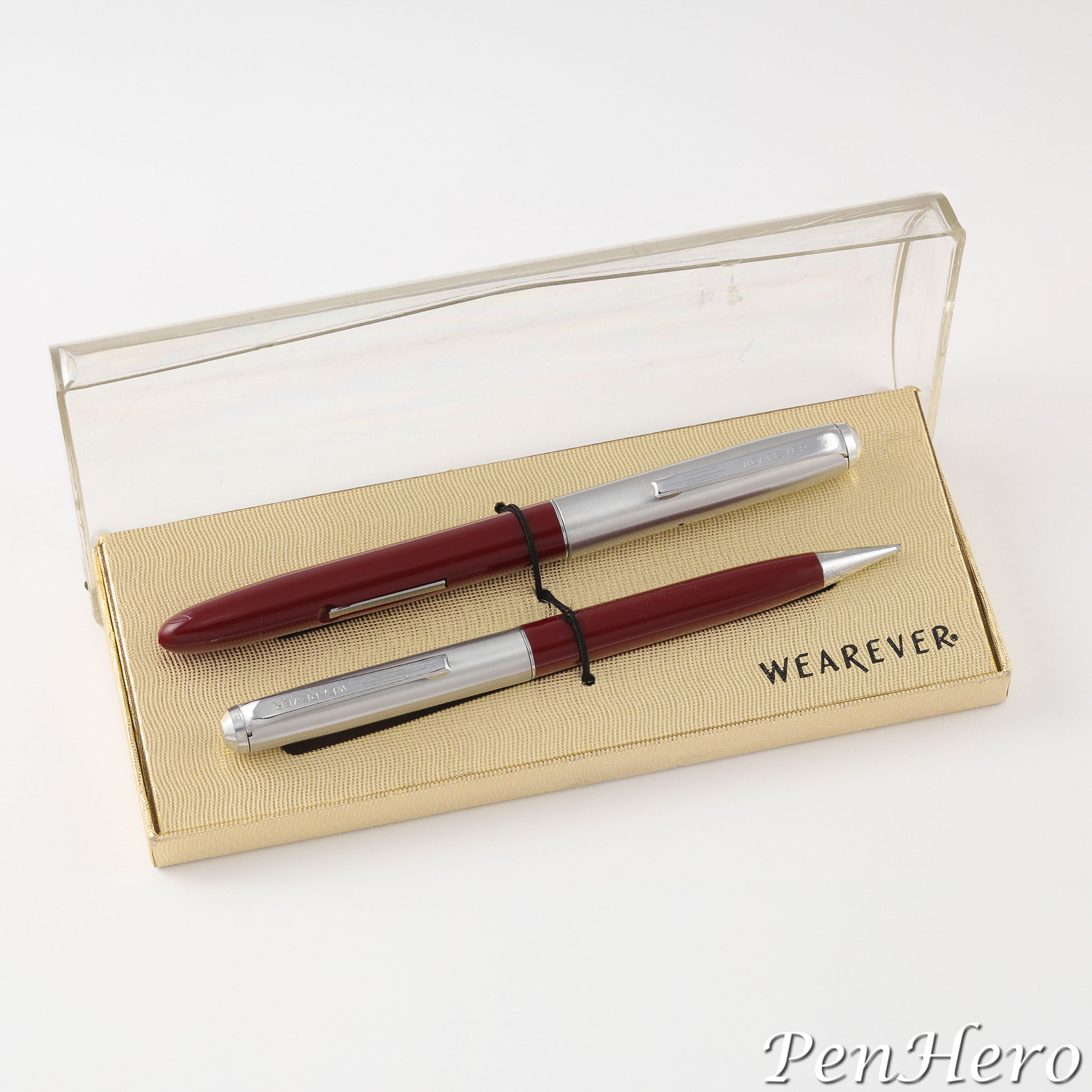 Wearever Pacemaker Maroon pen and pencil set 1955-1959
Wearever Pacemaker Maroon pen and pencil set 1955-1959
The second Pacemaker is distinctly different and quite uncommon. It has a Waterman Taperite style section with a tiny 14 karat gold nib sticking out from the end, a silver color metal cap, and an injection molded plastic body. I’ve only seen company advertisements for this pen appearing in 1947 and then they vanish. It appears that it may have first been offered as the 1947 Marlboro, possibly because the first Pacemaker was still being sold. The Marlboro was advertised as having a stainless steel, satin finish metal cap, which I believe is the “silvery metal” used on all of the following Wearever metal cap pens. Also in 1947, a nearly identical Wearever pen with a stainless steel nib was offered as a new version of the De Luxe. That De Luxe is clearly the precursor to the 1950s Pennant, a subject to be tackled in another article. The second Pacemaker was offered probably only from 1947-1948, based on the very few company and retailer advertisements I could find.
This third Pacemaker appears to be more upscale, if that can even be said, from the Pennant. The Pennant is the quintessential Wearever dollar pen of the 1950s. Heavily advertised nationally in Life magazine, The Saturday Evening Post, and others by David Kahn, Inc., from 1950-1956, and also by Wearever retailers. It was a lever-filler with an injection molded cap and barrel in a large number of colors. The cap has a silver color metal sleeve that gives it the appearance of having a metal cap. It sold for a dollar and was available with a matching pencil and later with a matching ballpoint pen. Pen and pencil sets came in a paperboard box. Pens alone came on retail hang cards or in slim paperboard boxes. The Pennant also featured a “Personal Point” that allowed the purchaser to buy any of five point sizes at the place of purchase, after the sale. This system was effectively a replacement for the entire front section with the ink sac attached, sold in a long box.
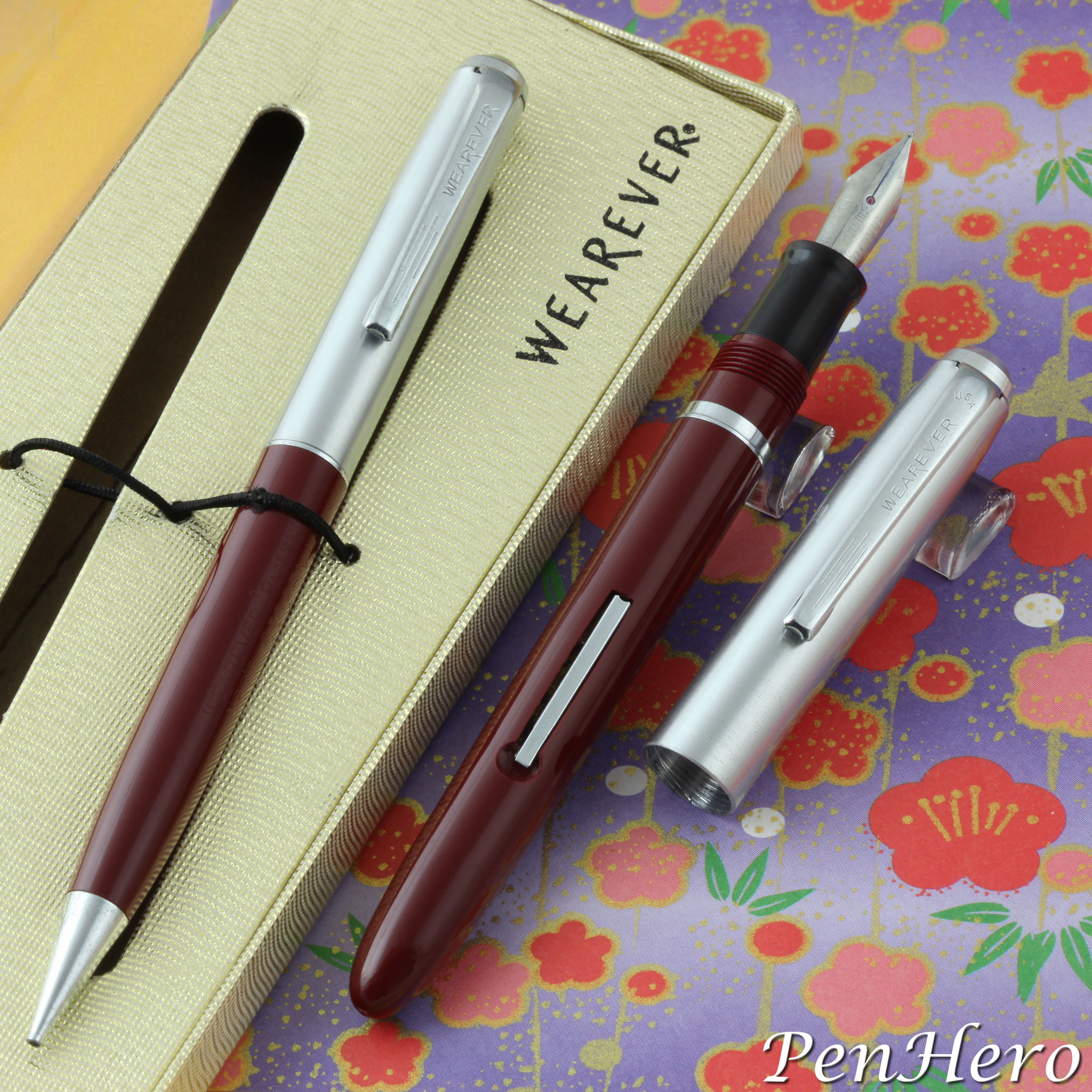 Wearever Pacemaker Maroon pen and pencil set 1955-1959
Wearever Pacemaker Maroon pen and pencil set 1955-1959
The Pennant was much more heavily promoted than the more expensive Pacemaker. I found no national advertisements for this third version of the Pacemaker and retailer ads for the Pennant outnumbered the Pacemaker by twelve to one. The Pacemaker may have been the top level pen, but the Pennant was the leader.
The 1955-1959 Pacemaker has a similar look to the Pennant but is a bit more “refined.” The barrels came in five colors, Blue, Maroon, Green, Grey, and Black, and some examples have matching color sections. It has an all metal, satin finish, silver color cap and a silver color metal cap top, clip, lever and trim piece on the section. These may all be made of stainless steel, but it’s not stated as such in any advertisements. I personally think they are. There are six exchangeable “Replace-A-Point” threaded nib units. This feature was similar to Esterbrook’s system, but the nibs are not interchangeable. The pen alone sold for $1.95 and for $3.25 with a matching twist action pencil. Pen and pencil sets came in a nicer paperboard box with a clear plastic cover. I’ve seen two types of these boxes, both shown here. Pens alone came in slim paperboard boxes.
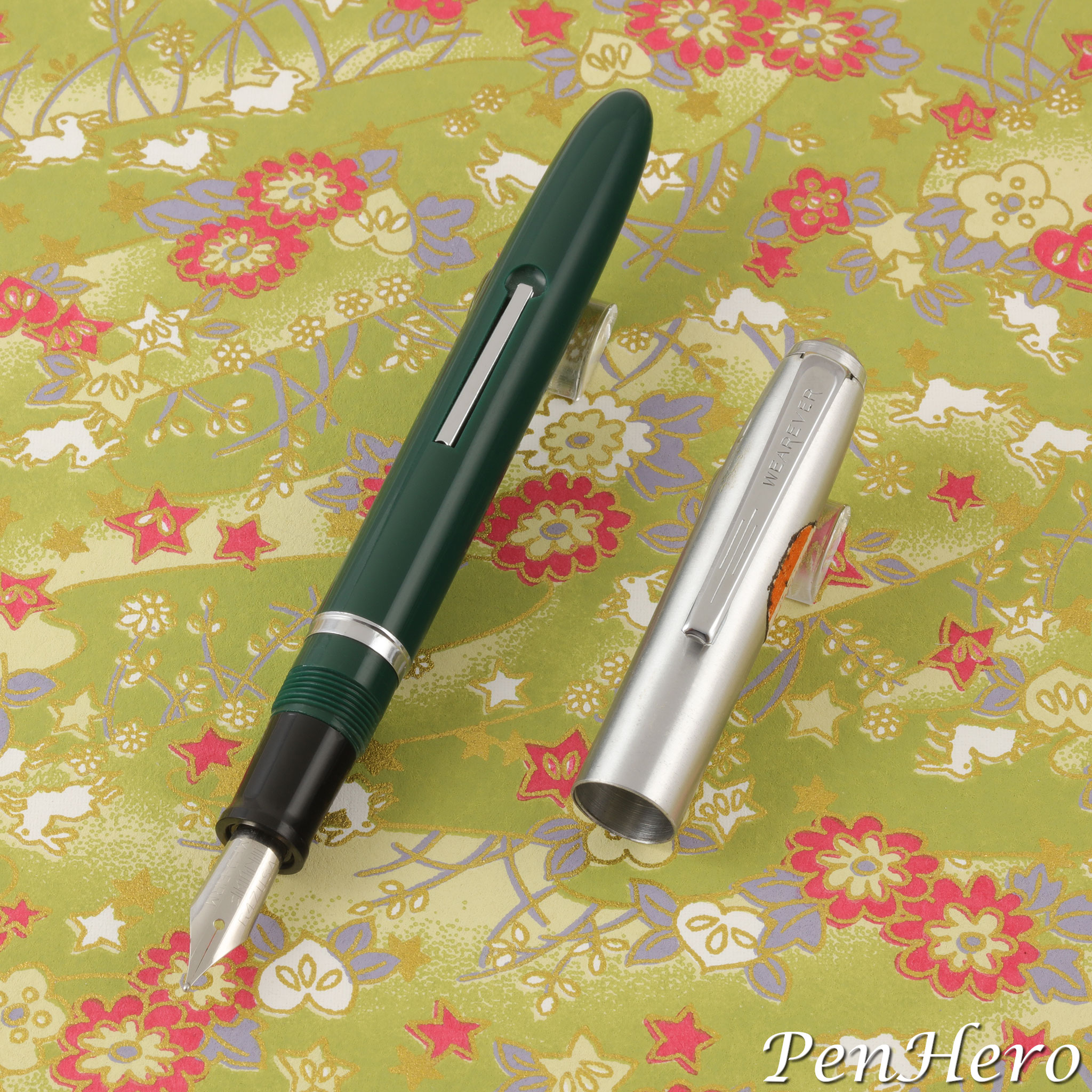 Wearever Pacemaker Green 1955-1959
Wearever Pacemaker Green 1955-1959
The earliest advertisement I could find for this Pacemaker was in the August 23, 1955 Pasadena, California Independent. No image is shown, but the price of $1.95 for the pen and the “Replace-A-Point” feature are mentioned. An advertisement in the August 28, 1955 Portland, Oregon Sunday Oregonian is the first that shows an image of the new pen along with a its features. The six “Replace-A-Point” nib grades are listed: extra fine, flexible fine, medium flexible, medium firm, broad, and steno. More features are listed in an advertisement in the September 7, 1955 Portland, Oregon Daily Journal, including the “Hardaloy” tipped nib, the clear feed (elsewhere called the “C-Flow” feed) that shows when it needs a refill, that it has a “vacuum sealed inner cap,” and the five colors available: Blue, Maroon, Green, Grey, and Black. The first mention of the pen and pencil set, showing it in the clear plastic cover case for $3.25 was in the December 15, 1955 Wilmington, Delaware News Journal. The latest advertisement I could find was in the August 27, 1959 Fort Worth, Texas Star-Telegram.
Identification Guide and Features:
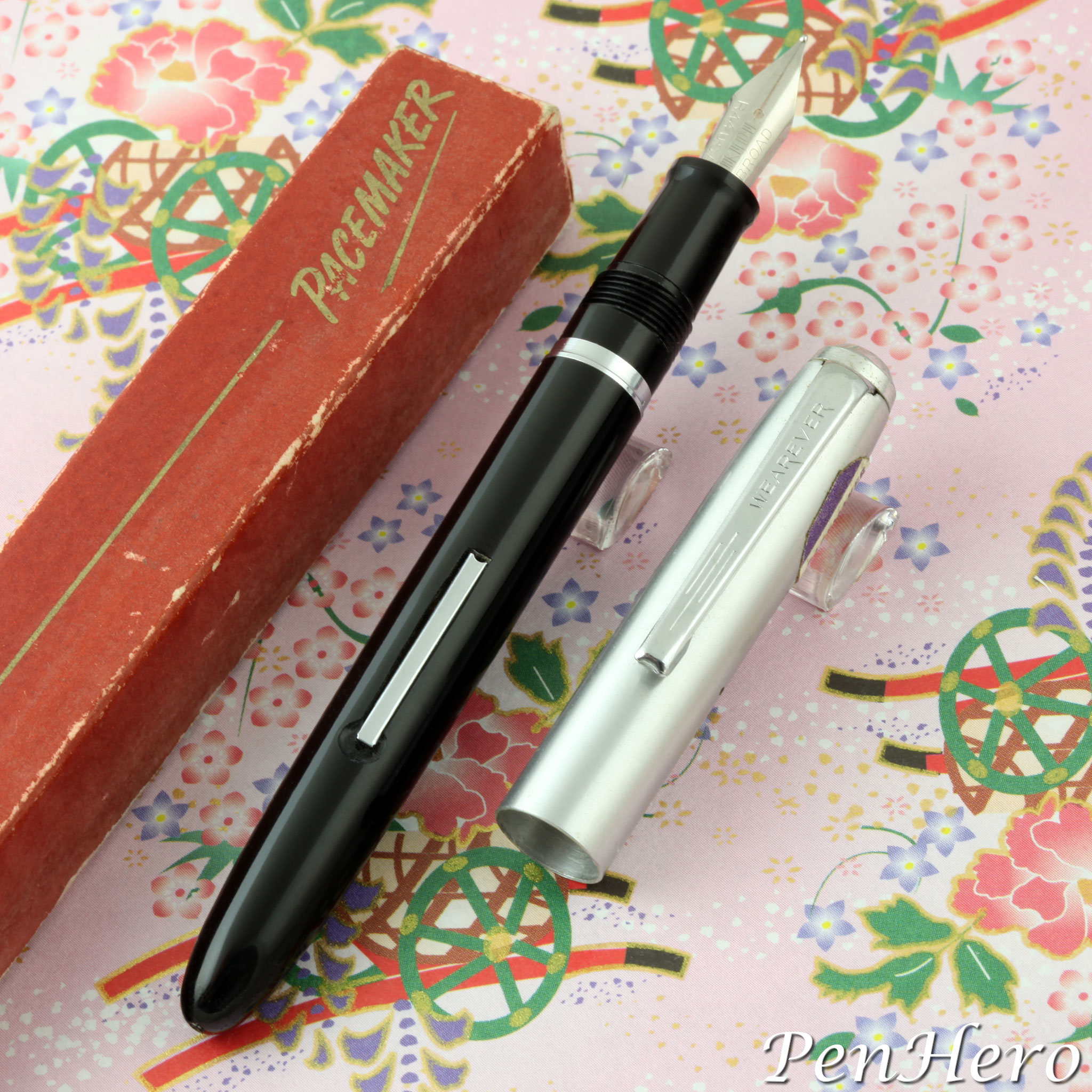 Wearever Pacemaker Black 1955-1959
Wearever Pacemaker Black 1955-1959
The Pacemaker is a lever-fill pen with an injection molded barrel and a threaded metal cap. What the satin finish, silvery, all metal cap is made of is not stated in advertisements, but the earlier Marlboro was clearly advertised as having a stainless steel, satin finish metal cap, which actually was just a sleeve over a plastic inner cap, so I believe the later "silvery metal" capped Pennant, De Luxe, and Pacemaker pens all are made with stainless steel, not aluminum. It's not known when pens with matching color sections were made nor if they were earlier or later than pens with black sections. Likewise, it's also not known when the clip tops were stamped with U S A and whether there is a relationship with the matching color sections. I've seen examples without the U S A stamping both with and without matching color sections, so I'm guessing the two things were not related. The green pens are more forest green and the grey pens are a shade of grey-green.
- Injection molded solid color plastic barrel in Blue, Maroon, Green, Grey, and Black
- Nib section on some pens match the barrel color, otherwise the section is black
- Silver color satin finish metal cap, probably stainless steel
- Silver color metal cap top
- Silver color metal clip stamped WEAREVER near the top and with three lines near the tip - some have U S A at the top
- Silver color metal trim piece on the barrel that meets flush with the cap when capped
- Silver color metal side lever
- Lever filler
- Threaded cap
- Barrel imprint on three lines: WEAREVER "PACEMAKER" over NORTH BERGEN, N. J. over U. S. A. - barrel imprints are often very light
- Stainless steel nib marked with nib grade on side face and nib number on opposing side face and WEAREVER down the center
- Six nib grades: extra fine, flexible fine, medium flexible, medium firm, broad, and steno
- Nib and feed are in a threaded unit that can be removed and replaced
- Clear "C-Flow" feed
- About 5 5/16 inches long capped and 6 inches posted
- Retail price for the fountain pen was $1.95, set with matching pencil was $3.25
- Pen packaged in slim paperboard boxes, pen and pencil set packaged in paperboard box with clear plastic flip open cover
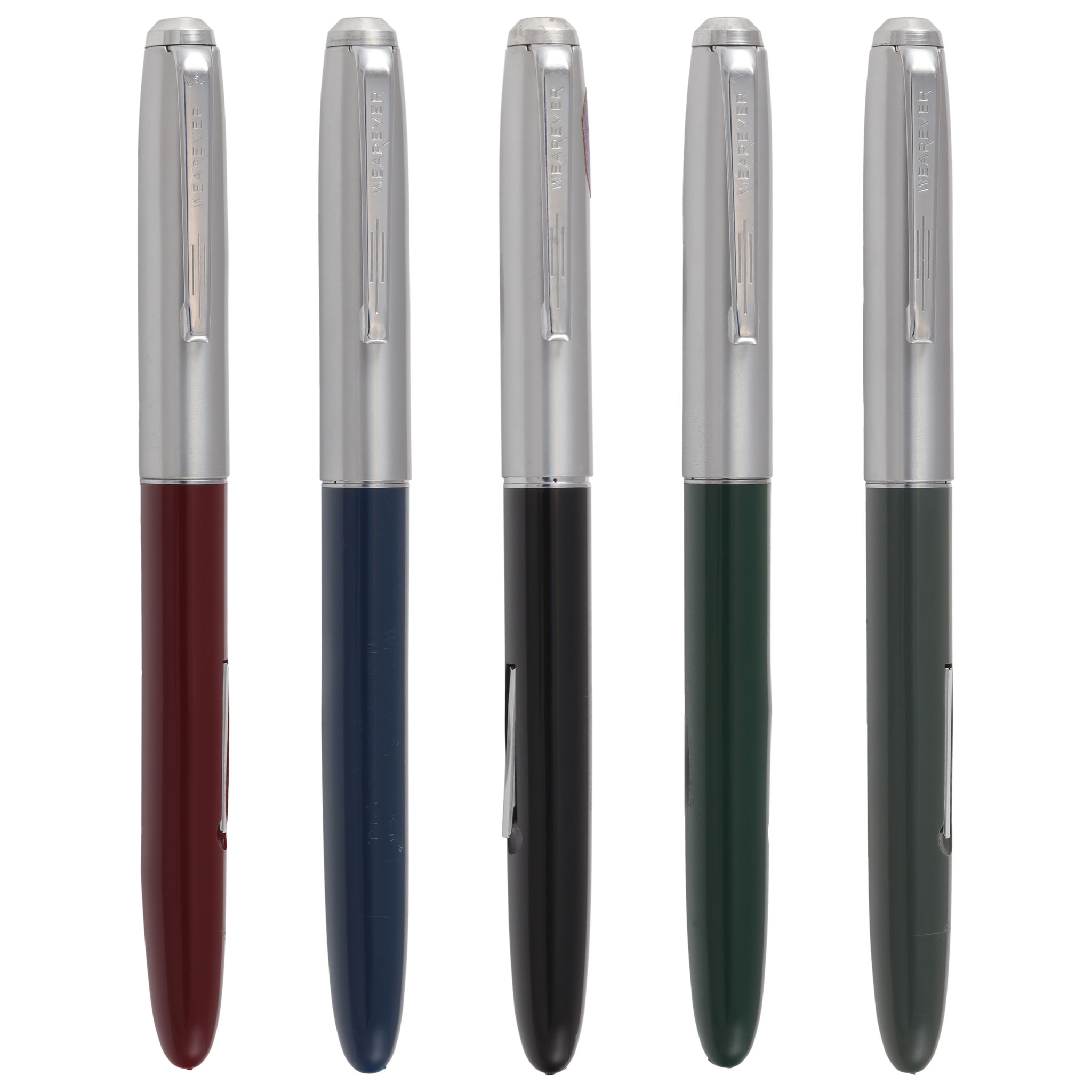 An array of Wearever Pacemaker pens 1955-1959
An array of Wearever Pacemaker pens 1955-1959
Performance
The 1955-1959 Pacemaker is pretty uncommon. They show up on eBay and at pen shows, but you may have to search for them. The imprint is usually faint, so unless the seller knows it’s a Pacemaker, it may be listed simply as a Wearever. The ones I’ve found are finished quite well for a cheap pen. All parts fit tightly together. The lever-fill mechanism works easily. Nibs write decently. The problem areas are few: all will have a sharp nub at the end of the barrel where the mold spur was broken off. Wearever hardly ever sanded those off on any pens. They are very prone to bending like a banana if subjected to heat. Other than that, a decent pen.
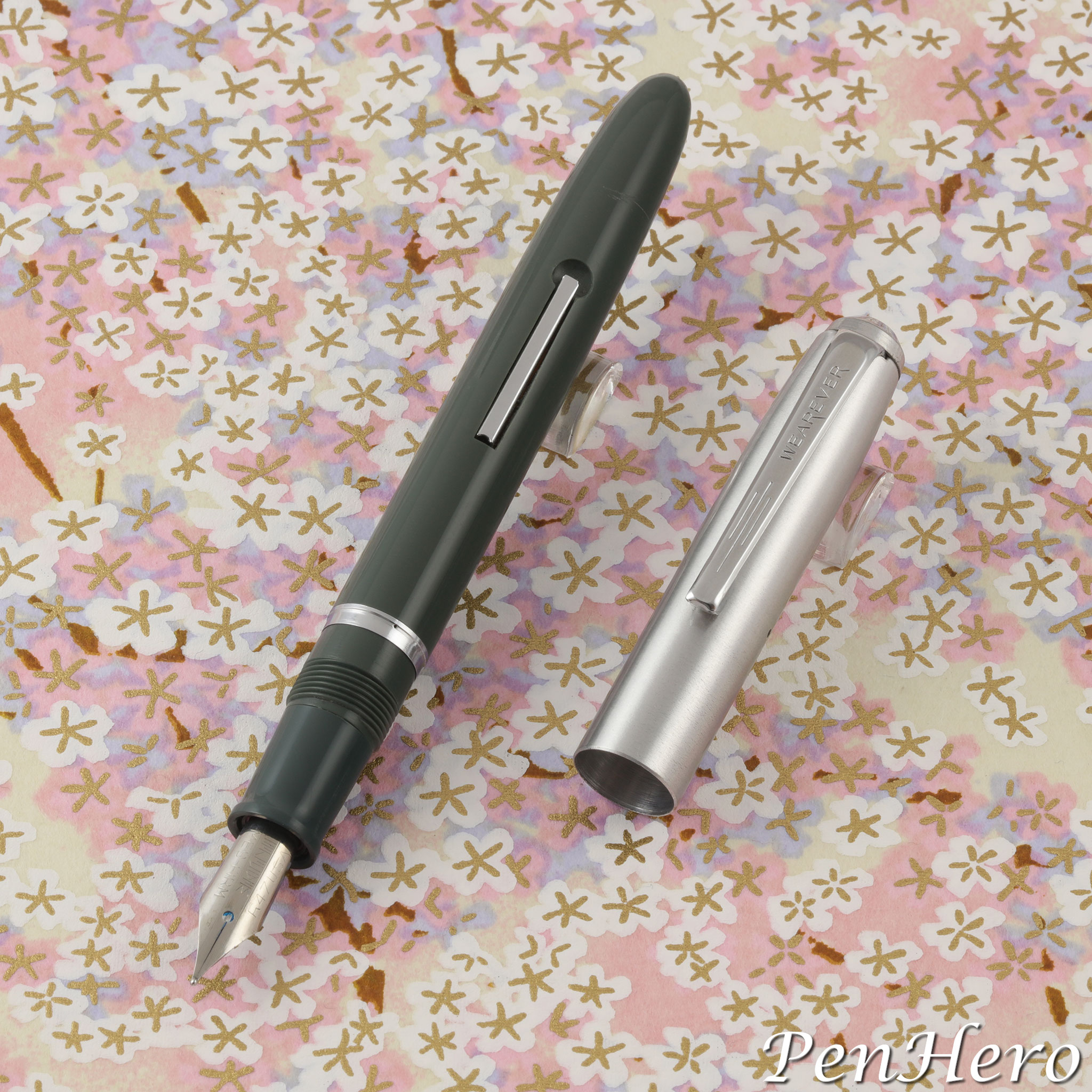 Wearever Pacemaker Grey 1955-1959
Wearever Pacemaker Grey 1955-1959
I test drove the Maroon Pacemaker featured in this article. It’s a standard size, about 5 5/16 inches long capped and 6 inches posted. It's light, similar to a Pennant, but feels better made. It’s long enough to write without posting the cap on the end of the barrel, so I left it off, worrying that the metal edge might cause scuffing.
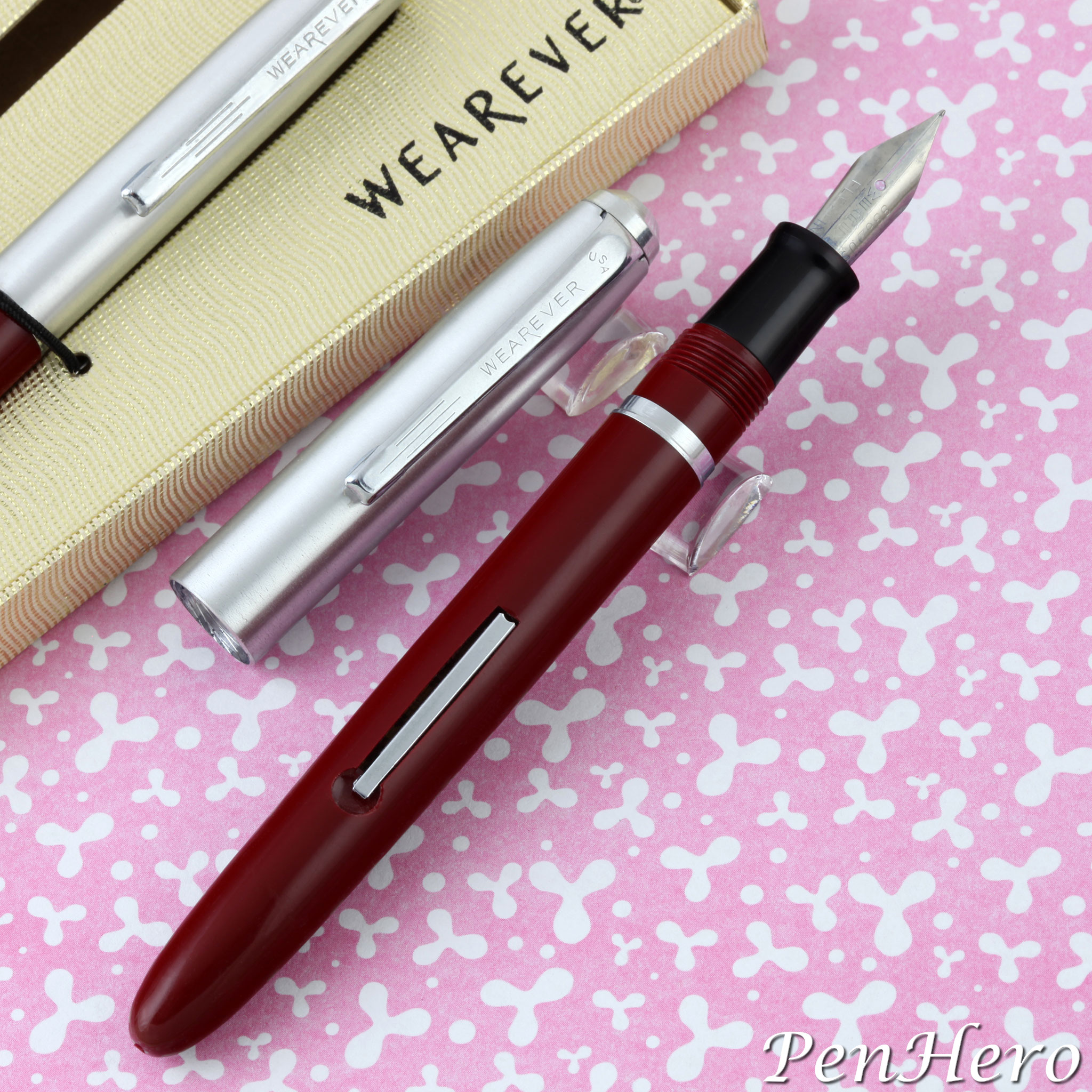 Wearever Pacemaker Maroon 1955-1959
Wearever Pacemaker Maroon 1955-1959
One stroke of the lever, a count to twenty, and a wipe of the nib and section and the Pacemaker is ready to write. I decided on this pen because the stainless steel nib is marked as a flexible fine. It turns out it’s barely a semi-flex nib. Pressing harder than I like or should will spread the tines just a little and provide some line variation, but it would hardly be called expressive. This is not a serious flexible nib. I don’t have other examples to try, but I have doubts they would be any better. Consider these to be firm nibs that are “sort of” flexible. Now let’s talk about the “Hardaloy” point. It feels pencil like, with a bit of drag, but no scratchiness, so not unpleasant, but it could be better. Does the “C-Flow” feed actually tell you that the pen needs ink. I did not do a full write out test, but I have my doubts.
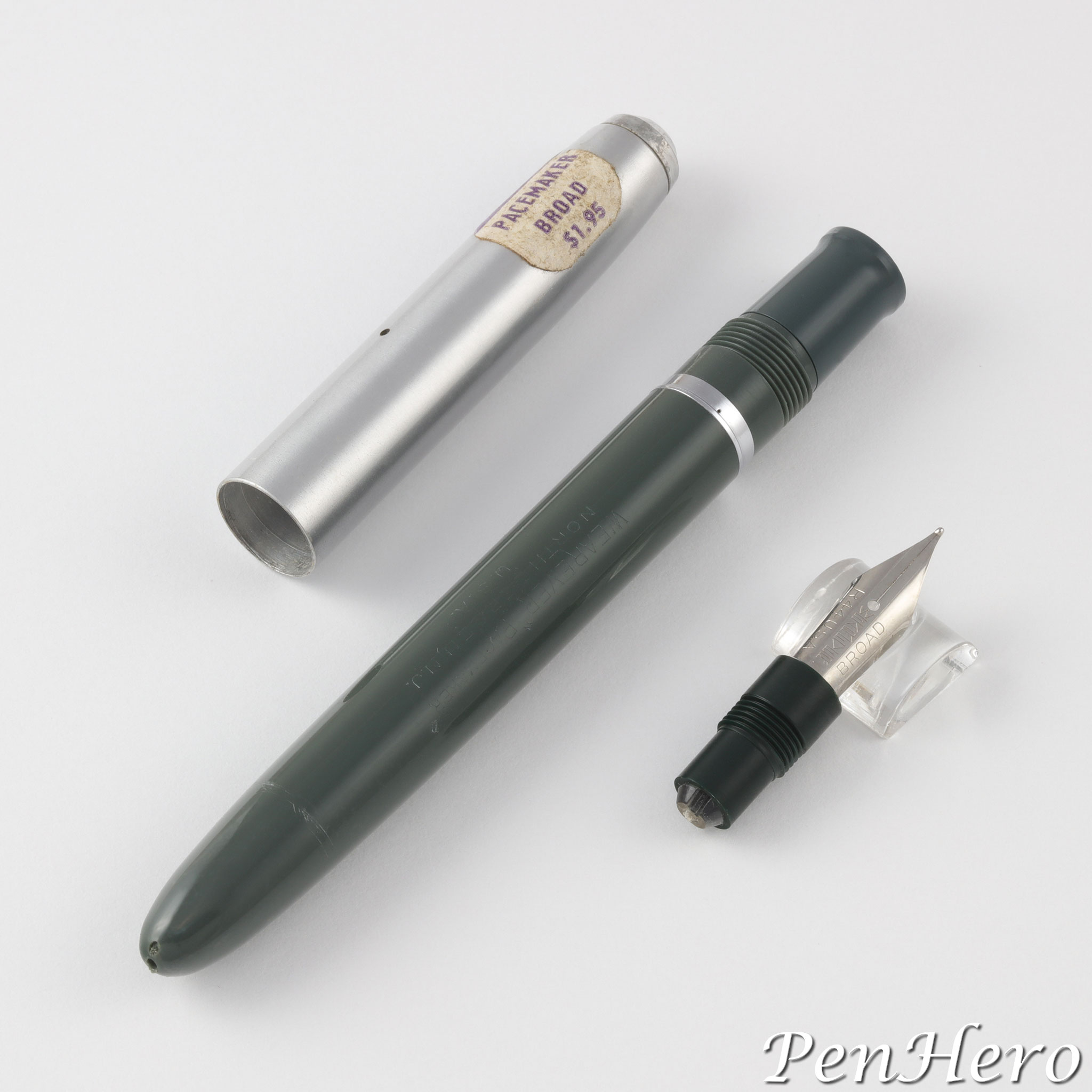 Wearever Pacemaker Grey with Replace-A-Point nib removed 1955-1959
Wearever Pacemaker Grey with Replace-A-Point nib removed 1955-1959
Is this a worthy daily use pen or an interesting “upscale” 1950s Wearever that only a Wearever collector would love? I think the Pacemaker is fun, but for daily use, the nib might need a little tweaking to make it a little less dry writing and a little smoother on paper. In 1955, if all you could afford was $1.95, then I would think the Pacemaker would be ok, but not great. If I wanted a decent pen in that price range, I would have looked at the $2.25 Sheaffer Fineline, which also had interchangeable points. Or I would save my money and get a $3.75 Sheaffer Cadet, which had sixteen exchangeable points available.
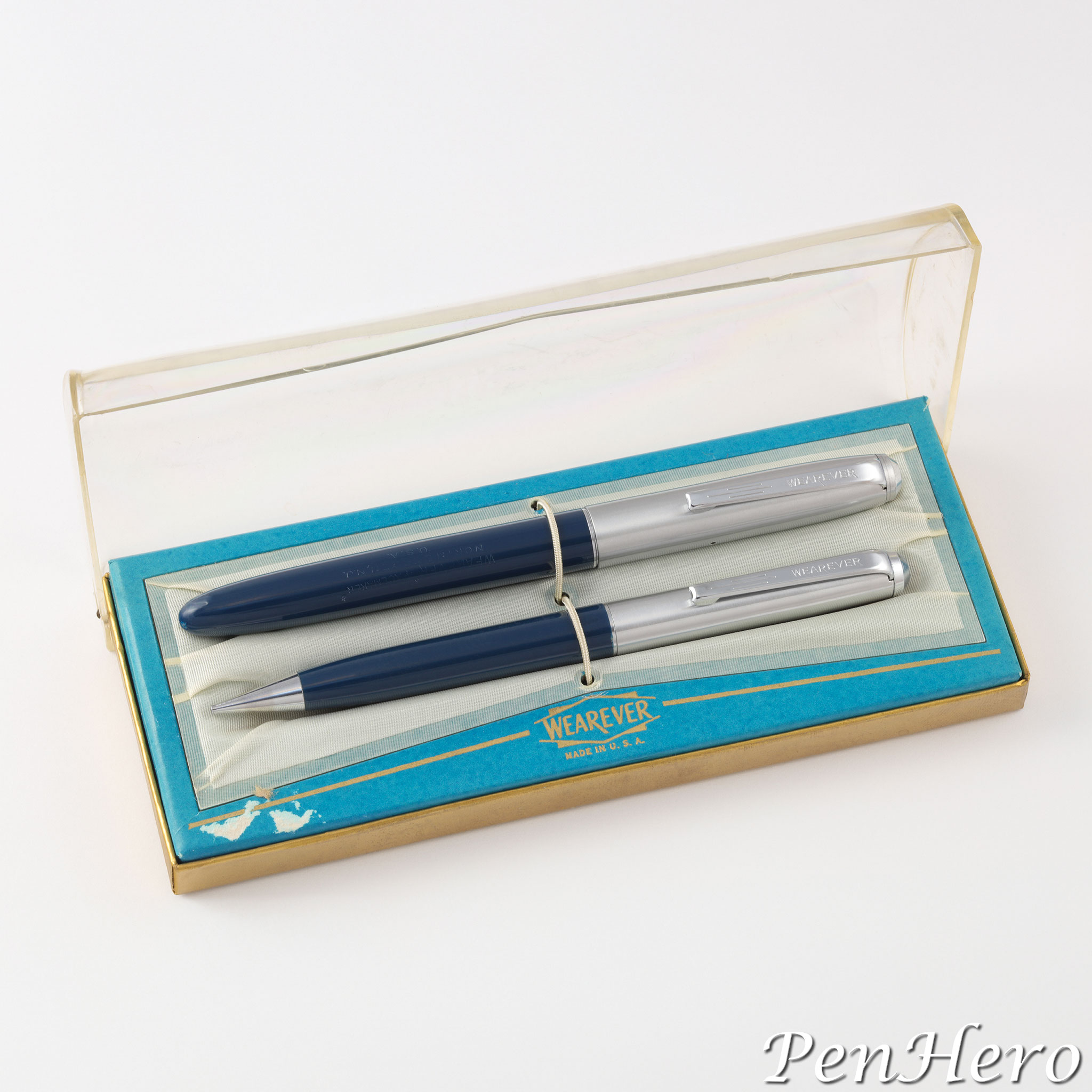 Wearever Pacemaker Blue pen and pencil set 1955-1959
Wearever Pacemaker Blue pen and pencil set 1955-1959
The Pacemaker is more uncommon than I would have thought, considering that many Wearever pens are easily available. I’ve not been able to find all six nib types yet, after years of looking. Maybe most were binned and lost to time. When found, they tend to cost similar to Pennants, so a complete collection, if it could be had, would not break the bank. Nothing like a completist Wearever collection!
References
Advertisement, Collier's Weekly, May 31, 1947, page 45
Advertisement, Collier's Weekly, June 14, 1947, page 103
Advertisement, Collier's Weekly, August 30, 1947, page 44
Advertisement, Collier's Weekly, September 13, 1947, page 95
Advertisement, Collier's Weekly, November 29, 1947, page 69
Advertisement, Collier's Weekly, December 13, 1947, page 74
Advertisement, Fort Worth Star-Telegram, Fort Worth, Texas, August 27, 1959, page 46
Advertisement, Life, May 19, 1947, page 14
Advertisement, Life, November 24, 1947, page 100
Advertisement, Life, December 8, 1947, page 147
Advertisement, Pasadena Independent, Pasadena, California, August 23, 1955, page 5
Advertisement, The News Journal, Wilmington, Delaware, December 15, 1955, page 31
Advertisement, The Oregon Daily Journal, Portland, Oregon, September 07, 1955, page 10
Advertisement, The Sunday Oregonian, Portland, Oregon, August 28, 1955, page 15
“David Kahn Dies At 84; Rites To Be Held Today” The Record, Hackensack, New Jersey, May 19, 1958, page 9
Trade-Mark Registrations Republished, Official Gazette of the United States Patent Office, United States Patent Office, March 30, 1954, page 1173
United States Trademark number 413,562, registered May 1, 1945, to David Kahn, Inc. of North Bergen, New Jersey, claimed in use since September 26, 1944
Wearever Pacemaker point of sale countertop stand, David Kahn, Inc., undated, c. 1955
Interact
Comments on this article may be sent to the author, Jim Mamoulides


